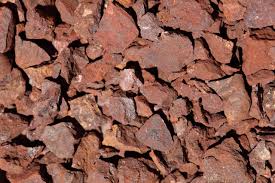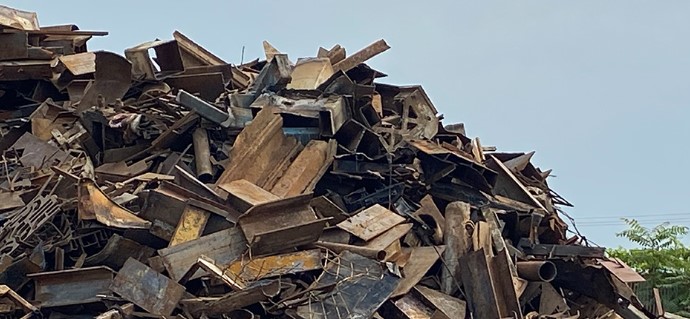What Are Ferrous Scrap Metals -Understanding, Sourcing & Recycling
Ferrous scrap metals are an important component of the recycling industry, playing a pivotal role in the conservation of natural resources and the reduction of environmental impact.
Ferrous metals, which include iron and its alloys, are distinct from non-ferrous metals like copper and aluminum. We look at the various aspects of ferrous scrap metal, from its definition and sources to its recycling process and economic and environmental benefits.
What is Ferrous Scrap Metal?
Ferrous scrap metal refers to scrap metal that contains iron, making it magnetic and prone to rusting when exposed to moisture. The primary types of ferrous metals include cast iron, wrought iron, and carbon steel. These metals are characterised by their durability and high tensile strength, which make them essential in construction and manufacturing industries.

Non-ferrous metals, such as aluminum, copper, and zinc, do not contain iron and are thus non-magnetic and more resistant to corrosion. Non-ferrous scrap metal is also valuable in recycling efforts but is distinguished from ferrous scrap by its properties and applications.
Sources of Ferrous Scrap Metal
Ferrous scrap metals are commonly found in various sectors, including the construction industry, automotive industry, and household items. Some prevalent sources are:
- Construction Industry: Structural steel from demolished buildings, sheet roofing, and large-scale piping.
- Automotive Industry: Car bodies, railroad tracks, and machinery parts.
- Household Appliances: Refrigerators, washing machines, and water pipes.
These sources ensure a steady supply of ferrous scrap metal for recycling facilities, contributing significantly to the world’s steel production.
The Recycling Process of Ferrous Scrap Metal
Scrap metal recycling involves several steps, ensuring that the materials are effectively processed and reused. The recycling process of ferrous scrap metal can be broken down into the following stages:
- Collection: Ferrous scrap metal is collected from various sources, such as construction sites, scrap yards, and households. Specialized companies often handle this collection, ensuring a steady supply of recyclable materials.
- Sorting: The collected scrap is sorted to separate ferrous metals from non-ferrous metals. This step is crucial as it ensures the purity of the recycled material. Magnetic separation is typically used to identify ferrous scrap due to its magnetic properties.
- Processing: The sorted ferrous scrap metal is then processed to remove any impurities. This may involve shredding the metal into smaller pieces to facilitate easier handling and melting.
- Melting: The processed scrap is melted in a furnace at high temperatures. This step is essential for removing any remaining contaminants and preparing the metal for reuse.
- Purification: Additional purification steps, such as using electrolysis, may be employed to ensure the metal is of high quality and free from impurities.
- Solidifying: The purified metal is then cast into specific shapes, such as bars or sheets, for use in manufacturing new products.
- Distribution: Finally, the recycled metal is distributed to various industries for use in the production of new steel products.
This comprehensive recycling process helps convert ferrous scrap metal into high-quality recycled materials, significantly contributing to environmental conservation and resource efficiency.
Economic Benefits of Recycling Ferrous Scrap Metal
The economic benefits of recycling ferrous scrap metal are substantial, impacting various facets of the economy. These benefits include:
- Cost Savings: Recycling ferrous scrap metal is generally more cost-effective than producing new metal from raw materials. This is because the energy required to melt and purify recycled metal is lower than that needed for mining and refining raw ores.
- Job Creation: The recycling industry creates numerous jobs in collection, sorting, processing, and distribution, thus contributing to economic growth and stability.
- Resource Conservation: By recycling ferrous scrap metal, industries can reduce their reliance on finite natural resources. This conservation effort is crucial for ensuring the sustainability of metal resources for future generations.
- Market Stability: Recycling helps stabilize the supply of metals, reducing the volatility associated with mining and raw material extraction.
These economic advantages underline the importance of recycling efforts in maintaining a sustainable and profitable recycling industry.
Environmental Impact of Recycling Ferrous Scrap Metal
Recycling ferrous scrap metal offers significant environmental benefits, including:
- Reduction in Greenhouse Gas Emissions: The recycling process produces less carbon dioxide and other greenhouse gases compared to the production of new metal from ores. This reduction helps mitigate climate change and promotes environmental health.
- Energy Conservation: Recycling ferrous metals requires less energy than extracting and processing virgin materials. This energy efficiency contributes to lower overall energy consumption in the manufacturing sector.
- Conservation of Natural Resources: By recycling scrap metal, we reduce the need for mining, which in turn conserves natural landscapes and reduces the environmental impact of mining activities.
- Pollution Reduction: Recycling minimizes the waste sent to landfills, reducing soil and water contamination. It also prevents the release of harmful chemicals and pollutants that can occur during the extraction and processing of raw materials.
These environmental benefits make recycling scrap metal a key component of sustainable development and environmental conservation efforts.
Challenges in Recycling Ferrous Scrap Metal
Despite its benefits, recycling ferrous scrap metal faces several challenges:
- Contamination: Ferrous scrap metal is often mixed with other materials, such as plastics and non-ferrous metals, which can complicate the recycling process. Effective sorting and purification methods are essential to address this issue.
- Market Fluctuations: The market for scrap metal can be volatile, influenced by global economic conditions and demand for raw materials. These fluctuations can impact the profitability and feasibility of recycling operations.
- Technological Limitations: Advances in recycling technology are necessary to improve the efficiency and effectiveness of recycling processes. Investment in research and development is crucial to overcome these technological barriers.
- Quality Control: Ensuring the quality of recycled metal is essential for its acceptance in various industries. Strict quality control measures must be implemented to maintain the standards required for different applications.
Addressing these challenges is vital for enhancing the efficiency and effectiveness of ferrous scrap metal recycling efforts.
Final Points
Ferrous scrap metals play a critical role in the recycling industry, offering numerous economic and environmental benefits. Understanding the sources, recycling process, and challenges associated with ferrous scrap metal is essential for maximizing its potential.
As the world moves towards more sustainable practices, the importance of recycling efforts in conserving natural resources, reducing greenhouse gas emissions, and promoting economic growth cannot be overstated. By continuing to invest in and improve recycling technologies, we can ensure a greener and more sustainable future for generations to come.

